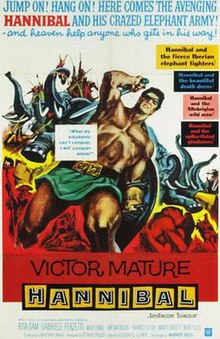Hannibal (1959 film)
| Hannibal | |
|---|---|
 | |
| Directed by | |
| Screenplay by |
|
| Story by | Ottavio Poggi[1] |
| Produced by |
|
| Starring | |
| Cinematography | Raffaele Masciocchi[1] |
| Edited by | Renato Cinquini[1] |
| Music by | Carlo Rustichelli[1] |
Production company | Liber Films |
| Distributed by | Warner Bros. |
Release dates |
|
Running time | 95 minutes[1] |
| Languages | English Italian |
| Budget | $2.5 million[2] |
| Box office | $1,550,000 (US/ Canada)[3] |
Hannibal (Italian: Annibale) is a 1959 Italian historical adventure film based on the life of Hannibal, starring Victor Mature in the title role. The film was directed by Edgar G. Ulmer and Carlo Ludovico Bragaglia. It marks the first film pairing of Terence Hill and Bud Spencer under their real names. However they only appear in supporting roles and have no scenes in common.
Plot
[edit]The film begins with the Roman Senate hearing about Hannibal (Victor Mature) crossing the Alps with his men and many elephants. The crossing is difficult, with many men dying en route, but they manage to pass through, in part because Hannibal forms an allegiance with a local chieftain.
Hannibal's troops capture Sylvia, niece of Roman senator Fabius Maximus, and she and Hannibal fall in love. Some of Hannibal's troops oppose the match and an unsuccessful attempt is made on Sylvia's life. Hannibal also loses an eye during battle.
Despite the warnings of Fabius, who suggests avoiding battle and waging a campaign of exhaustion, the decision is made to fight Hannibal out in the open. The consequence is a massive Roman defeat at Cannae.
Fabius is recalled to lead the Roman Army and the momentum of Hannibal's campaign begins to wane. His wife and child arrive from Carthage. Sylvia returns to Rome and commits suicide. A postscript informs us that Hannibal fought on for many more years in other lands.
Cast
[edit]- Victor Mature as Hannibal
- Gabriele Ferzetti as Fabius Maximus
- Rita Gam as Sylvia
- Milly Vitale as Danila
- Rik Battaglia as Hasdrubal
- Franco Silva as Maharbal
- Terence Hill as Quintilius (billed under his real name, Mario Girotti)
- Mirko Ellis as Mago
- Andrea Aureli as Gajus Terentius Varro
- Andrea Fantasia as Consul Paulus Emilius
- Bud Spencer as Rutario (billed under his real name, Carlo Pedersoli)
- Renzo Cesana
- Mario Pisu
- Enzo Fiermonte
Production
[edit]Despite being an Italian production the film was mainly financed by American studio Warner Brothers.
Victor Mature signed to make the film with Liber Films of Rome in March 1959. Filming took place in October 1959 with a reported budget of $2.5 million.[2] Edgar Ulmer was the American representative of the company.[4]
The only English speaking actors in the film were Victor Mature and Rita Gam. All the other actors were Italian and had their lines dubbed into English.[5] The film featured approximately 20,000 extras.
The film was originally intended to be a more personal account of Hannibal's life, but the studio instead pressured the film makers into developing a more standard historical film. The film was directed by Edgar G. Ulmer, although IMDB lists Carlo Ludovico Bragaglia as a co-director. The film was released theatrically in the USA on 18 June 1960.
The film existed in two versions, a 95-minute version released in non-English speaking European countries, and a 103-minute version released in the US and other English speaking territories. The films tagline was "Jump on! Hang on! Here comes the avenging Hannibal and his crazed elephant army!"[1] The film's music was composed by Carlo Rustichelli.
Release
[edit]Hannibal was released in Italy on 21 December 1959 and in the United States on 18 June 1960.[1]
DVD release
[edit]The film was released on DVD in the USA on October 19, 2004. The DVD includes 16:9 format, a 33-minute interview with Edgar G. Ulmer, a photo and poster gallery, the theatrical trailer, and cast and crew biographies. The DVD contains no subtitles.
References
[edit]Footnotes
[edit]- ^ a b c d e f g h i Kinnard & Crnkovich 2017, p. 77.
- ^ a b Scheuer, Philip K. (Mar 18, 1959). "Mature Gets Lead in Big 'Hannibal': 'Prisoner' Author at Columbia; Glamour Dead, Says Crawford". Los Angeles Times. p. B9.
- ^ "Rental Potentials of 1960", Variety, 4 January 1961 p 47. Please note figures are rentals as opposed to total gross.
- ^ THOMAS M. PRYOR (Mar 18, 1959). "BRITON TO WRITE U. S. MOVIE SCRIPT: Bridget Boland Assigned to 'Devil at Four O'Clock' -Hathaway Gets Job". New York Times. p. 46.
- ^ Scott, John L. (Sep 7, 1959). "Zsa Zsa Will Play Western Heroine: Gruber's 'The Gambling'Lady' Set for Hungarian Fireball". Los Angeles Times. p. C11.
Sources
[edit]- Kinnard, Roy; Crnkovich, Tony (2017). Italian Sword and Sandal Films, 1908–1990. McFarland. ISBN 978-1476662916.
External links
[edit]- 1959 films
- 1950s historical adventure films
- 1950s biographical films
- Italian historical adventure films
- Italian biographical films
- 1950s English-language films
- English-language Italian films
- 1950s Italian-language films
- Films directed by Edgar G. Ulmer
- Films directed by Carlo Ludovico Bragaglia
- Films scored by Carlo Rustichelli
- Films set in the Roman Empire
- Films set in Tunisia
- Films set in Spain
- Films set in Italy
- Films set in the Alps
- Films shot in Serbia
- Films about elephants
- Second Punic War films
- Cultural depictions of Hannibal
- Warner Bros. films
- Sword-and-sandal films
- 1950s multilingual films
- Italian multilingual films
- 1950s Italian films
- English-language historical adventure films
- English-language biographical films
